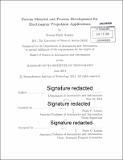| dc.contributor.advisor | Paulo C. Lozano. | en_US |
| dc.contributor.author | Arestie, Steven Mark | en_US |
| dc.contributor.other | Massachusetts Institute of Technology. Department of Aeronautics and Astronautics. | en_US |
| dc.date.accessioned | 2014-10-08T15:20:37Z | |
| dc.date.available | 2014-10-08T15:20:37Z | |
| dc.date.copyright | 2014 | en_US |
| dc.date.issued | 2014 | en_US |
| dc.identifier.uri | http://hdl.handle.net/1721.1/90652 | |
| dc.description | Thesis: S.M., Massachusetts Institute of Technology, Department of Aeronautics and Astronautics, 2014. | en_US |
| dc.description | Cataloged from PDF version of thesis. | en_US |
| dc.description | Includes bibliographical references (pages 109-113). | en_US |
| dc.description.abstract | Ion electrospray propulsion devices rely on the transportation of ionic liquid propellant to emission regions where ions are extracted at high velocities. One such method involves the use of porous substrates to passively transport propellant towards conically shaped features of the same porous material. Historically, the methods of fabricating such small features (~150[mu]m tapered to ~20[mu]m over a height of ~150[mu]m) are subtractive, in that material is selectively removed from a substrate to reveal the desired features. The limitations of these processes include but are not limited to: process repeatability, complex operation, material selection limited by the process, serial operation, and long/expensive fabrication time. With an understanding of these limitations, the goal of this research is to explore new materials and processes to identify candidates for electrospray propulsion applications. In particular, processes that allow for additive tip manufacturing, parallel processing, and uniformity in addition to materials that allow for variable and uniform porosity have been studied. As part of this research, the sol-gel and freeze casting methods for producing porous materials were characterized to better identify feasibility for electrospray propulsion. Characterization includes the feasibility of molding porous tips directly onto substrates. As a result of this research, porous substrates from different materials and varying pore sizes were fabricated via both methods. A porous emitter tip prepared by the sol-gel method was fired and shown to extract current at levels exceeding the state of the art. Finally, a new process, entitled sol freeze, was invented that utilizes the benefits of both the sol-gel and freeze casting methods. Additionally, porous material research for the purpose of contact electrodes was investigated. In order to lengthen the electrochemical window during electrospray thruster firing, a desire for conductive porous materials with large internal surface area was discovered. Carbon xerogel electrodes with embedded wires were designed and fabricated through this research. Specifically, carbon xerogel electrodes with internal surface areas on the order of 500 m² /g were fabricated and tested. | en_US |
| dc.description.statementofresponsibility | by Steven Mark Arestie. | en_US |
| dc.format.extent | 113 pages | en_US |
| dc.language.iso | eng | en_US |
| dc.publisher | Massachusetts Institute of Technology | en_US |
| dc.rights | M.I.T. theses are protected by copyright. They may be viewed from this source for any purpose, but reproduction or distribution in any format is prohibited without written permission. See provided URL for inquiries about permission. | en_US |
| dc.rights.uri | http://dspace.mit.edu/handle/1721.1/7582 | en_US |
| dc.subject | Aeronautics and Astronautics. | en_US |
| dc.title | Porous material and process development for electrospray propulsion applications | en_US |
| dc.type | Thesis | en_US |
| dc.description.degree | S.M. | en_US |
| dc.contributor.department | Massachusetts Institute of Technology. Department of Aeronautics and Astronautics | |
| dc.identifier.oclc | 890391338 | en_US |
